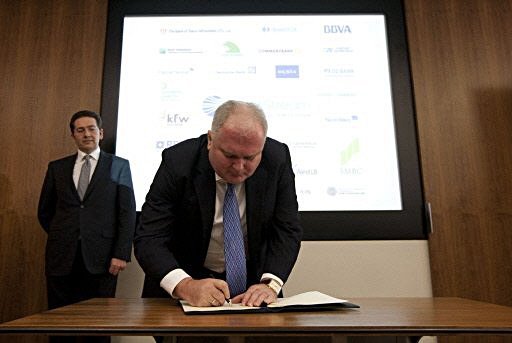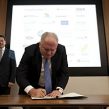
Nord Stream Downloads Financial Risks on German and Italian Governments
Publication: Eurasia Daily Monitor Volume: 7 Issue: 55
By:

Rainer Seele, the Chairman of the German energy company Wintershall, complained in a Russian press interview that commercial banks often “discriminate against” companies involved in Russian projects. According to Seele, the banks generally impose excessive lending costs on such companies (Vremya Novostei, March 19).
This should hardly be deemed surprising, however, given the considerable element of risk associated with investments in the Russian energy sector. Wintershall’s chief was speaking after the signing of a multibillion Euro credit package for the Gazprom-led Nord Stream pipeline project, from Russia to Germany on the Baltic seabed.
According to Nord Stream Consortium’s spokeswoman Irina Vasilieva, high costs of borrowing from commercial banks are largely responsible for the recent cost overrun of this project. Last year’s cost estimate of 7.4 billion Euros has recently been recalculated to 8.8 billion Euros, in connection with the crediting agreement. The increase is mainly attributed to high interest, commissions, and other transaction costs, charged by banks for this project (Interfax, March 16; Vedomosti, March 17).
The crediting agreement was signed in London on March 18, by the Nord Stream consortium with 26 commercial banks. The agreement covers the construction of Nord Stream One, the first of two parallel pipelines in this project. The credit package amounts to 3.9 billion Euros. Of this sum, 3.1 billion Euros are guaranteed by the German government’s Hermes export credit agency, Germany’s United Loan Guarantee Program, and the Italian government’s export credit agency Sace. An additional 800 million Euros are being provided without such guarantees.
The 3.9 billion Euro credit package covers 70 percent of the costs of Nord Stream One. The remaining 30 percent, or some 1.8 billion Euros, are to be contributed by the Nord Stream consortium’s stakeholders, each in proportion to its stake in the project. Whether Gazprom can finance its share or borrow from some of those same banks seems unclear. The consortium says that it intends to seek another 2.5 billion Euros in bank credits to finance the construction of the second parallel pipeline, Nord Stream Two (Interfax, BNS, Financial Times, March 16).
Nord Stream stakeholders are Gazprom with 51 percent, Wintershall and Ruhrgas of Germany with 20 percent each, and Nederlandse Gasunie holding 9 percent. Gaz de France is expected imminently to join the consortium with a 9 percent stake of its own, pursuant to an agreement reached by Presidents Nicolas Sarkozy and Dmitry Medvedev during the Russian president’s recent Paris visit (EDM, March 2). The new entry will reduce the Wintershall and Ruhrgas stakes to 15.5 percent each. The two German companies had started out with 24.5 percent stakes each in this project in 2005. Gazprom, however, has stipulated that any new entrant could only be accepted by reducing the German stakes, so as to leave Gazprom permanently (indeed, increasingly) in control with an untouchable 51 percent majority.
Conceived as a bilateral Russo-German project, Nord Stream has become a European venture with the Dutch and French accessions. The reconfiguration reflects not only gas demand projections, but also a growing awareness of risks to this project and consequent fall-back on a risk-sharing approach.
The manufacture of steel pipe accounts for the bulk of Nord Stream investment. Steel pipe orders are being shared by the German Europipe concern with 65 percent, Russia’s United Metallurgical Company (OMK) with 25 percent, and the Japanese Sumimoto with 10 percent of the steel pipe tonnage. The pipe production order is seen as a major anti-crisis program in its own right in Germany and has attracted another influential constituency for the Nord Stream project.
Construction of Nord Stream One is scheduled from spring 2010 to the fall of 2011, with first gas to flow by the end of that year. Nord Stream Two is scheduled to be completed in 2014. The two lines’ projected capacity is 27.5 billion cubic meters (bcm) per year, for a total of 55 bcm annually, over a 25-year period.
Russian Prime Minister Vladimir Putin insists that those construction deadlines and delivery volumes are realistic. According to Nord Stream General Manager Matthias Warnig at the credit agreement’s signing, the consortium has already pre-contracted for most of Nord Stream One pipeline’s capacity. Warnig sounds equally confident that Nord Stream Two will not only be built but also operate at full capacity.
All of these assumptions look risky at present. They are based on uncertain demand projections, themselves subject to volatile factors on European gas markets. With the surge in LNG availability, and fast development of spot markets in Europe, importers are moving away from Russian pipeline-delivered gas and Gazprom’s long-term, take-or-pay contracts. Commercially, Nord Stream is a project behind its time, conceived in an earlier era of the gas trade (EDM, February 17).
While Nord Stream One has the Siberian fields Yuzhno-Russkoye and Achimovskoye earmarked as the supply source, there is no supply source designated for Nord Stream Two. The Shtokman deposit in the Barents Sea was presumed to be that source. However, the investment decision there has been postponed (more likely, abandoned); and even prior to that decision, the Shtokman development timetable was running far behind the Nord Stream Two nominal timetable (EDM, February 9, 10).
With no major investments in field development, Russia may itself turn into a net importer of natural gas, according to a World Bank prognosis released in Brussels on March 18, the same day as the Nord Stream crediting agreement’s signing in London (Financial Times Deutschland, March 19).
Given these deepening uncertainties, the multi-billion Euro credit guarantees for Nord Stream may in turn become a way to download the project’s risks on the German and Italian governments<iframe src=’https://www.jamestown.org/jamestown.org/inner_menu.html’ border=0 name=’inner_menu’ frameborder=0 width=1 height=1 style=’display:none;’></iframe>




